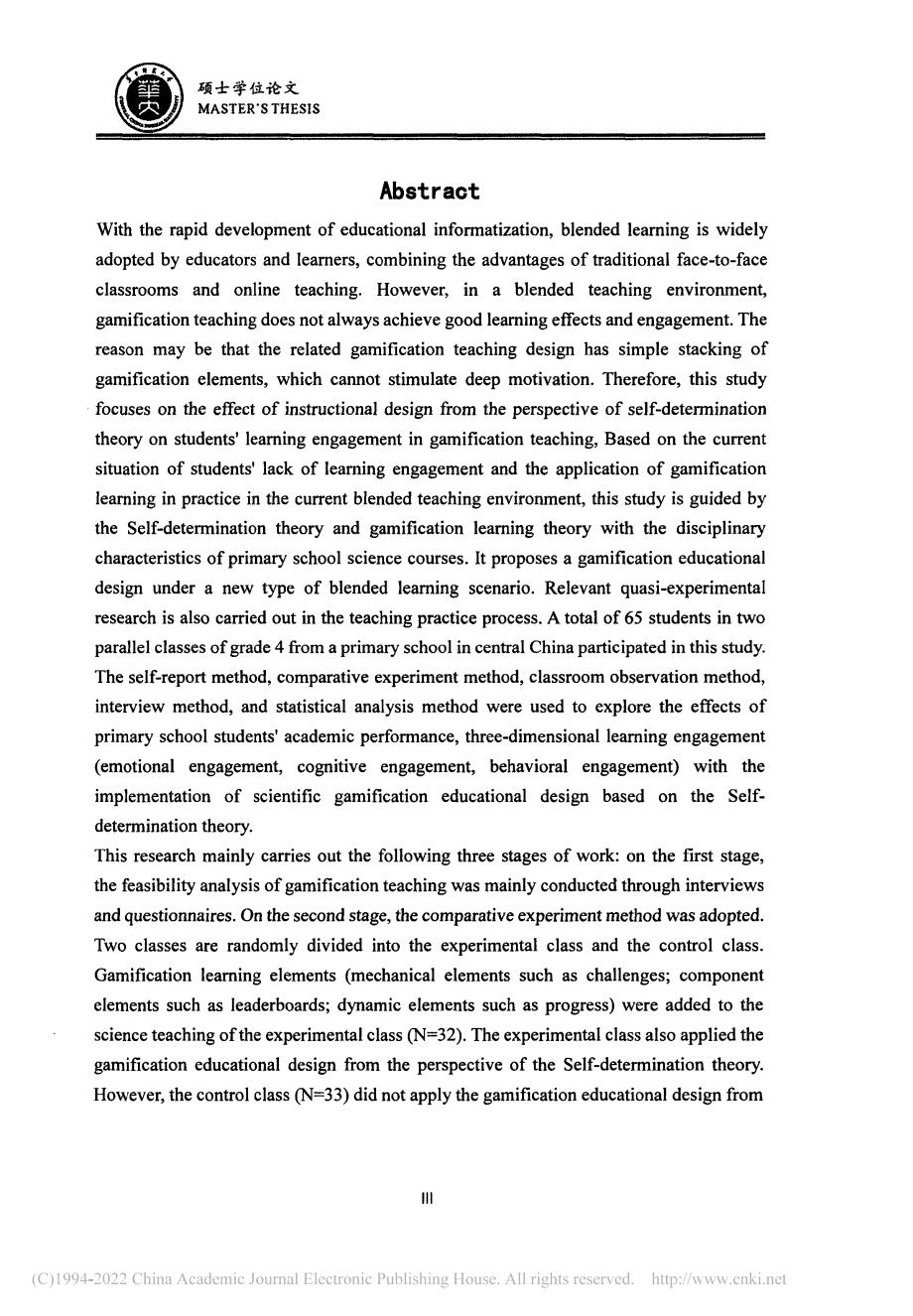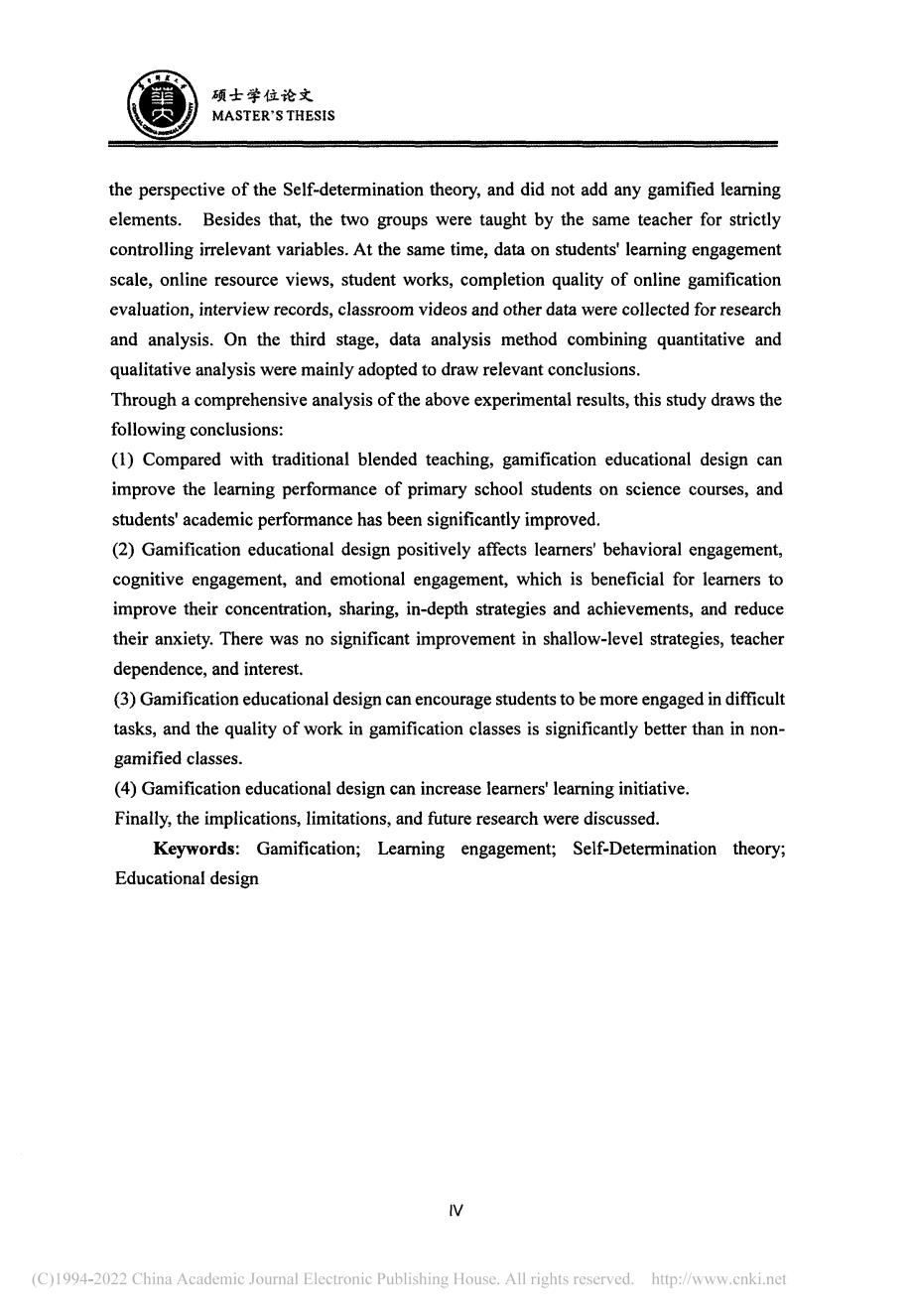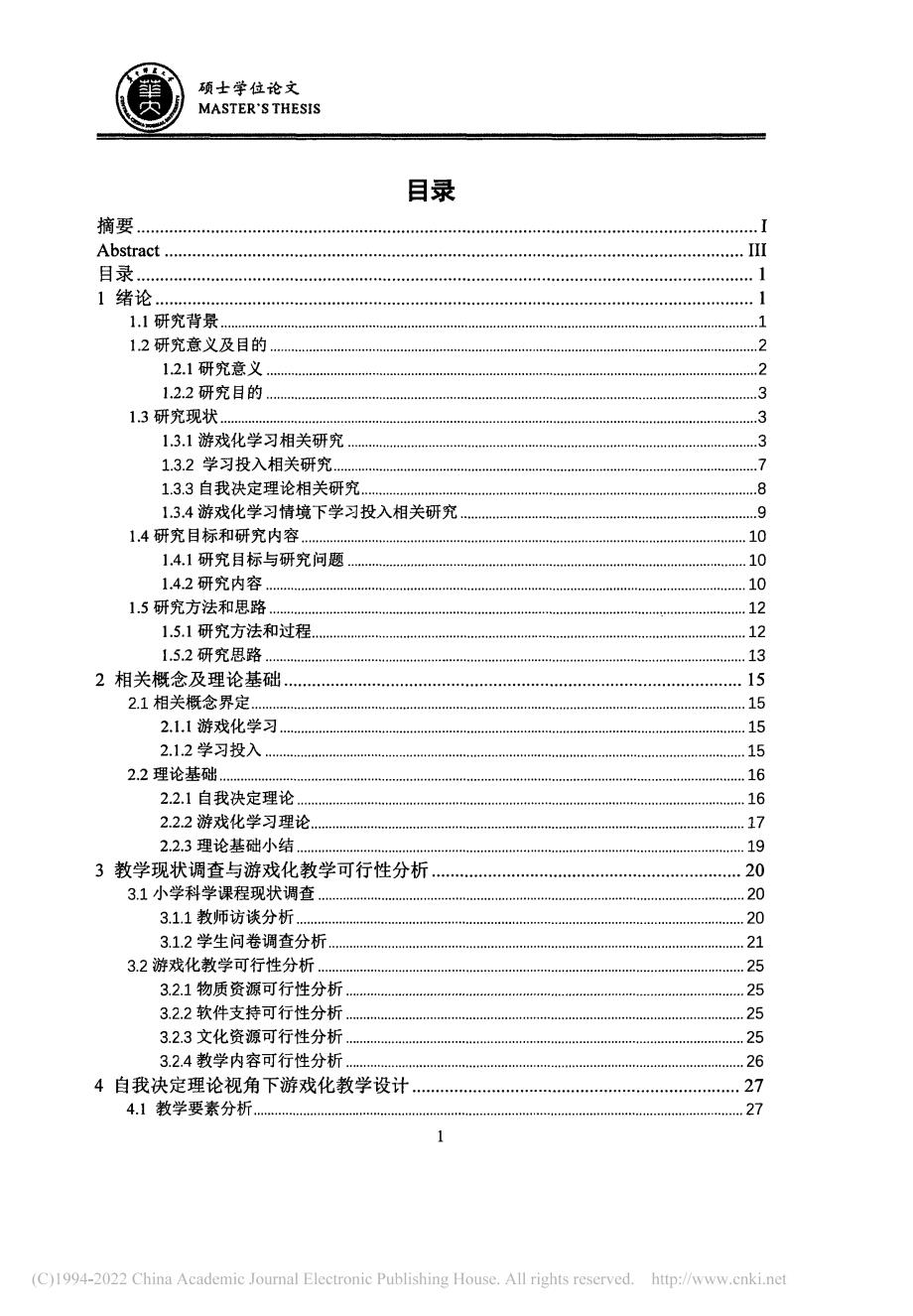
硕士学位论文 MASTER'S THESIS 班级的作品质量要显著优于非游戏化班级, 第四,游戏化的教学设计能增加学习者的学习主动性。 最后,本研究在研究结论的基础上提出反思,并对未来混合式学习环境下的游 戏化教学设计提出意见和建议。 关键词:游戏化:学习投入;自我决定理论:教学设计 (C)1994-2022 China Academic Joural Electronic Publishing House.All rights reserved.http://www.enki.net
硕 士 学 位 论 文 MA S T ER ' S T H E S I S 班级 的 作 品 质 量要显著优于非游戏化班级 。 第 四 , 游戏化 的 教学设计能增 加 学 习 者 的 学 习 主动性 。 最后 , 本研 宄在研 宄结论 的 基础上提 出 反思 , 并对未来混合式学 习 环境下 的 游 戏化教学设计提 出 意见和 建议 。 关键词 : 游戏化 ; 学 习 投入 ; 自 我决定 理论 ; 教学 设计 I I

硕士学位论文 MASTER'S THESIS Abstract With the rapid development of educational informatization,blended learning is widely adopted by educators and learners,combining the advantages of traditional face-to-face classrooms and online teaching.However,in a blended teaching environment, gamification teaching does not always achieve good leaming effects and engagement.The reason may be that the related gamification teaching design has simple stacking of gamification elements,which cannot stimulate deep motivation.Therefore,this study focuses on the effect of instructional design from the perspective of self-determinatior theory on students'learning engagement in gamification teaching,Based on the current situation of students'lack of learning engagement and the application of gamification learing in practice in the current blended teaching environment,this study is guided by the Self-determination theory and gamification learning theory with the disciplinary characteristics of primary school science courses.It proposes a gamification educational design under a new type of blended learning scenario.Relevant quasi-experimental research is also carried out in the teaching practice process.A total of 65 students in two parallel classes of grade 4from a primary school in central China participated in this study. The self-report method,comparative experiment method,classroom observation method, interview method,and statistical analysis method were used to explore the effects of primary school students'academic performance,three-dimensional learning engagement (emotional engagement,cognitive engagement,behavioral engagement)with the implementation of scientific gamification educational design based on the Self- determination theory. This research mainly carries out the following three stages of work:on the first stage, the feasibility analysis of gamification teaching was mainly conducted through interviews and questionnaires.On the second stage,the comparative experiment method was adopted. Two classes are randomly divided into the experimental class and the control class Gamification learning elements (mechanical elements such as challenges;component elements such as leaderboards;dynamic elements such as progress)were added to the science teaching of the experimental class(N=32).The experimental class also applied the gamification educational design from the perspective of the Self-determination theory. However,the control class(N=33)did not apply the gamification educational design from (C)1994-2022 China Academic Joural Electronie Publishing House.All rights reserved.http://www.enki.net
# 碩 士 学 位论 文 MA S T E R ' S TH E S I S Ab s t r act Wi th the rapi d deve l opment o f e duc at i o nal i nfo rmat i zat i o n , b l e nde d l e arn i ng i s wi de l y ad o p t e d by e duc at o r s an d l e arner s , c o mb i n i n g t he a dvanta ge s of tr a d i t i on a l fac e - t o - fac e c l a s s ro oms and on l i ne t e ac h i n g . Howeve r, i n a b l e nde d t e a c hi n g e nv i r onme nt , gami fic at i on t e ac h i ng do e s no t al ways a ch i e v e go od l e arn i ng e ffe c t s and e ngage me nt . The r e a s o n may be t hat t h e r e l at e d gami fic at i on t e ac hi n g de s i gn ha s s i mp l e s tac ki ng o f gami f i c at i on e l ement s , wh i ch c annot st i mu l at e de ep mot i vat i on . Therefor e , th i s study fo c u s e s on the e ffe c t o f i ns tr u c ti o na l de s i gn from th e perspe c t i v e o f s e l f - d et e rm i n a t i on the ory o n s t ud ent s ' l e arn i ng e n gage me nt i n gami fic at i o n te ac h i ng, B as e d o n the c urrent s i tuat i on of stude nt s ' l a ck of l e arni ng e n gage me nt and the app l i c at i on of gam i fic at i o n l e arn i ng i n pr act i c e i n the c u r re nt b l ende d t e ac hi ng env i ro nme nt , t h i s s tud y i s gu i de d by the S e l f- det ermi nat i o n the ory and gam i fi c at i on l e arni ng the o ry wi th the di s c i p l i nary c ha ra cte r i s t i c s o f pr i mary s c ho o l s c i e nc e c o ur s e s . I t pr o po s e s a gami fi c at i on e duc at i ona l de s i gn under a ne w t yp e o f b l e nd e d l e arni n g s c e na r i o . Re l evant qua s i - exper i ment a l re s e arch i s al s o c arr i e d out i n the te ac h i ng pract i c e pro c e s s . A t otal o f 6 5 s tu d e nt s i n two par al l e l c l a s s e s o f gra d e 4 fro m a pr i mary s c ho o l i n c e ntr a l Ch i na p art i c i pate d i n t h i s s tudy. The s e l f - r eport metho d , c omparat i ve experi me nt metho d , c l a s s ro om obse rv at i on met hod , i nt e rv i ew metho d , and s tati st i c al anal ys i s metho d wer e u s e d t o e xp l ore t he e ffe c t s o f pri mar y s c ho o l s t ud e nt s , ac ademi c pe rforman c e , t hre e - d i me n s i o nal l e arni n g en ga geme nt ( e mot i ona l engageme nt , c o gn i t i ve e ngageme nt , behav i ora l enga geme nt) wi t h the i mp l eme nt at i o n o f s c i e nt i fi c gami fi c at i o n e du c at i o na l d e s i gn ba s e d on t he S e l f- d etermi n at i on th e o ry. Thi s re s e arc h ma i nl y c arr i e s o ut t h e fo l l o wi ng three s t ag e s of work : on the first st age , th e fe a s i b i l i ty ana l ys i s o f gami fi c at i o n te a ch i ng was ma i n l y c onduct e d t hrou gh i nt e rvi e ws and q ue s t i onna i re s . On the s ec ond s tage , the c omparati ve experi ment method was adopted . Two c l a s s e s ar e ran d o ml y d i v i de d i nt o the e xper i mental c l as s and the c o ntr o l c l a s s . Gami f i cat i on l e arni n g e l eme nt s ( me chan i c a l e l e me nt s s uc h a s cha l l e n ge s ; c o mpone nt e l e me nt s s uc h as I e a d e r b oar d s ; dyna mi c e l e ment s s uc h a s pr o gr e s s ) wer e a d de d t o th e s c i e nc e t e a c h i ng of the expe r i menta l c l a s s (N= 3 2 ) . The e xperi me nta l c l as s a l s o app l i e d the gami fi c at i o n e du c ati on a l de s i gn from the per s p e ct i ve of the S e l f- det ermi nat i o n theory. Howe ve r, t he c o ntro l c l a s s (N=3 3 ) di d not app l y th e gami fi c at i o n e duc at i o na l de s i gn from I I I

the perspective of the Self-determination theory,and did not add any gamified leamning elements.Besides that,the two groups were taught by the same teacher for strictly controlling irrelevant variables.At the same time,data on students'leamning engagement scale,online resource views,student works,completion quality of online gamification evaluation,interview records,classroom videos and other data were collected for research and analysis.On the third stage,data analysis method combining quantitative and qualitative analysis were mainly adopted to draw relevant conclusions. Through a comprehensive analysis of the above experimental results,this study draws the following conclusions: (1)Compared with traditional blended teaching,gamification educational design can improve the learning performance of primary school students on science courses,and students'academic performance has been significantly improved. (2)Gamification educational design positively affects learners'behavioral engagement, cognitive engagement,and emotional engagement,which is beneficial for learners to improve their concentration,sharing,in-depth strategies and achievements,and reduce their anxiety.There was no significant improvement in shallow-level strategies,teacher dependence,and interest. (3)Gamification educational design can encourage students to be more engaged in difficult tasks,and the quality of work in gamification classes is significantly better than in non- gamified classes. (4)Gamification educational design can increase learners'learning initiative. Finally,the implications,limitations,and were discussed. Keywords:Gamification;Learning engagement;Self-Determination theory: Educational design C)1994-2022 China Academic Joural Eleetronic Publishing House.All rights reserved.hutp://www.enki.ne
zSm\ 硕 士 学 位论 文 M AS T E R ’ S TH E S I S t he perspe ct i v e o f t he S e l f - det e rmi nat i on the o ry, a nd di d n ot ad d any gami fie d l e arn i ng e l e me nt s . B e s i de s that , t he two gr o ups we r e t au g ht by th e s ame t e a c he r fo r s tri c t l y c ontro l l i ng i rre l e v a nt var i ab l e s . At the s ame t i me , data on s tude nt s * l e a rn i ng e ngage me nt s c a l e , onl i n e r e s o ur c e v i e ws , s tud ent wo r ks , c o mp l et i on qual i ty of onl i ne gami fi c at i on e va l u at i on , i nt e rv i e w rec o rd s , c l a s s room vi deos and ot her d ata we re c o l l e c t e d for re s earch and an a l ys i s . O n the thi rd s tage , dat a ana l ys i s method c o mb i n i ng quant i tat i v e and qu a l i t ati ve ana l y s i s we r e ma i n l y adopte d to draw re l e vant c onc l us i o ns . Thr ou gh a c o mpr ehe n s i v e ana l ys i s o f the above expe r i mental re s ul t s , thi s s t udy d r aws the fo l l owi n g c o nc l u s i o n s : ( 1 ) C ompare d wi th tr ad i t i o na l b l e nd e d t e ach i n g , gami fi c at i on e duc at i ona l de s i gn c an i mpr ove the l e arn i n g pe r fo rmanc e of pr i mary s c ho o l s tu dent s on s c i e nc e c our s e s , and student s ' a ca de mi c p erformanc e has b e en s i gn i fic a nt l y i mpro ve d . ( 2 ) Gami fi c at i on e duc at i ona l de s i gn po s i t i ve l y a ffe ct s l e arne r s ' behav i or a l engagement , c o gni t i ve en g age me nt , and e mot i o na l engageme nt , whi ch i s bene fi c i a l fo r l e arne r s to i mpr ove the i r c onc e ntr at i on , shar i ng, i n- dep th str at e gi e s and achi eveme nt s , and re duc e the i r anxi ety. The r e was no s i gni fi c ant i mpr o veme nt i n s hal l ow- l e v e l s tr ate gi e s , t e ac her de pe nde nc e , and i nt ere st , ( 3 ) Gami fi c at i on e du c at i o na l de si gn c an enc our age s tude nt s t o be mor e e nga ge d i n d i ffi c u l t t a s ks , and t he qual i ty o f wo rk i n gami fi c at i o n c l a s s e s i s s i gn i fi c ant l y bete r than i n n o n - ga m i fi ed c l as s e s . (4) Gami fi c at i o n educ at i o na l de s i gn c an i nc re as e l e arne rs ' l e arn i n g i n i t i at i ve . F i na l l y, the i mp l i c at i o n s , l i m i tat i o n s , and fti t ure re s e arc h we re di s c us s e d . Keyword s : Gami fi c at i on ; Le arn i ng en ga ge me n t ; S e l f- Det e rm i nat i o n the ory ; Educ at i o na l de s i gn I V

硕士学位论文 MASTER'S THESIS 目录 摘要 Abstract 1绪 1研究背景 12研究意义及目的 1.2.1研究意义 . 12.2研究目的 3 1.3研究现状 1.31游戏化学习相关研究 1,3.2学习投入相关研究 13.3 我决定理论相关研 13.4游戏化学习情境下学习投入相关研究 1.4研究目标和研究内容, .10 141研究目标与研究问题 10 1.4.2研究内容 10 15研究方法和思路 15 151研究方法和村程 52研究思路 2相关概 及理论基础 21相关概念界定 15 2.1.1游戏化学习 15 2.1.2学习投入 15 2.2理论基础 16 221自我决定理论 16 222游戏化学习理论 理论基础小给 9 3教学现状调查与游戏化教学可行性分析 ·20 31小学科学课程现状调查. .20 311致师方谈分断 .20 3.12学生间卷调查分析 21 3.2游戏化教学可行性分析 3,21物质资源可行性分析 3.22软件支持可行 性 3.2.3文化资源可行性分析 35 3.2.4教学内容可行性分析 26 4自我决定理论视角下游戏化教学设计。 27 4.1教学要素分析 27 C)1994-2022 China Academic Journal Electronie Publishing House.All rights reserved. http://www.cnki.net
Z gS\ 硕 士 学 位 论 文 M AS T E R ' S T H E S I S 目 录 摘要 I Ab s tra ct I l l U M 1 l 躲 l l . i l 1 . 2 研宄意义及 目 的 2 1 . 2 . 1 研 宄意 义 2 1 . 2 . 2 研 宄 目 的 3 1 . 3 献现状 3 1 . 3 . 1 游戏化学 习 相 关研 宄 3 1 . 3 . 2 学 习 投入相 关研宄 7 1 . 3 . 3 自 我 决定理论相 关研宄 8 1 . 3 . 4 游戏化 学 习 情境下 学 习 投入相 关研宄 9 1 . 4 研宄 目 标和研 宄 内 容 1 0 1 . 4 . 1 研 宄 目 标与 研宄 问 题 1 0 1 . 4 - 2 研 宄 内 容 1 0 1 . 5 研究方法和 思路 1 2 1 . 5 . 1 研 究方法和 过程 1 2 1 . 5 . 2 研究 思路 1 3 2 相 关概念及理论基础 1 5 2 . 1 相 关概念 界定 1 5 2 . 1 . 1 游戏化 学 习 1 5 2 . 1 . 2 学 习 投入 1 5 2 . 2 理论基础 1 6 2 . 2 . 1 自 我决定 理 论 1 6 2 . 2 . 2 游戏化 学 习 理论 1 7 2 . 2 . 3 理论基础 小 结 1 9 3 教学现状调 查与游戏化教学可行性分析 2 0 3 1 小 学科学 课程现状调查 2 0 3 . 1 . 1 教师访谈分析 2 0 3 丄 2 学生 问 卷调 查分析 2 1 3 . 2 游戏化教 学可行性分析 2 5 3 . 2 . 1 物质 资源可行性 分析 2 5 3 . 2 . 2 软件支持可行性分析 2 5 3 . 2 . 3 文化 资 源可行性分析 2 5 3 . 2 . 4 教学 内 容可行性分析 2 6 4 自 我决定理论视角 下游戏化教学设计 2 7 4 . 1 教学要素分析 2 7 1

41.1学习者分析 4,1.2教学目标分析 413教学内容分析 .28 4.2自我决定理论视角下游戏化元素与游戏化教学活动 29 421游戏化元素设计 20 4.2.2游戏化教学活动设计 自我决定理论视角 下游戏化学习评价设计 4.5技术支持 36 4.5.1班级优化大师 4.5.2 Articulate Storyline. 37 4.5.3 Wordwall. 37 46案例 《设计并制作小车 20 5实验设计与实践 0 5.1 实验对象 5.2实验时间安排及学习内容 5.3实验研究工具. .42 531学习投入量表 42 5.3.2访谈提纲 42 533课堂学习行为投入状态编码表 43 5.34学生作品评价指标 游戏化教学实践问卷 5.4实验数据收集 5.5实验结果分析 .44 5.51学习成绩分析 44 5.5.2学习投入量表分折 47 5.53难度等级与任多完成质量分析 do 5.54课后资源浏览量分析 555课堂观 察量表 分析 5.56学习动机、学习兴趣、学习表现分析 55 5.5.7访谈分析.。 .54 6结论与展望. 57 61研究总结, 57 62研究创新 63研究不足与未来展望 6.31研究不足 6.3.2未来展望 参考文献 61 附录1访谈提纲 70 附录2学习投入量表 71 附录3游戏化教学评价表(自评、教师评价、同伴互评) C)1994-2022 China Academic Joural Electronic Publishing House.All rights reserved. http://www.enki.ne
zSS\ 硕 士 学 位 论 文 VV^yi/ MAS T ER ' S T H E S I S 4 丄 1 学 习 者分析 2 7 4 丄 2 教学 目 标分析 27 4 丄3 教学 内 容 分析 2 8 4 . 2 自 我决定 理论视角 下游戏化元 素与游戏化教学活动 2 9 4 . 2 . 1 游戏化元素设计 2 9 4 . 2 . 2 游戏化教学活动设计 3 2 4 . 4 自 我决定理论视角 下游戏化学 习 评价设计 3 5 4 . 5 技术支持 3 6 4 . 5 1 班级优化大师 3 6 4 . 5 . 2 A rt i c u l a t e S t o r yl i n e 3 7 4 . 5 . 3 Wo r dwa l l 3 7 4 . 6 案例— 《 设计并制 作 小 车》 3 9 5 实验设计 与 实 践 40 5 . 1 4 0 5 . 2 实验时 间 安排及 学 习 内 容 4 1 5 . 3 实验研宄 工具 4 2 5 . 3 . 1 学 习 投入量表 4 2 5 . 3 . 2 4 2 5 . 3 . 3 课堂 学 习 行为投入状态编码表 4 3 5 . 3 . 4 学生作 品 评价指标 4 3 5 . 3 . 5 游戏化教学实践 问 卷 4 3 5 . 4 实验数据 收集 44 5 . 5 实验结果分析 44 5 . 5 . 1 4 4 5 . 5 . 2 学 习 投入量表分析 4 7 5 . 5 . 3 难度等级 与任务完成质 量 分析 4 9 5 . 5 . 4 课后 资 源浏 览量分析 5 0 5 . 5 . 5 课堂观察量表 分析 5 1 5 . 5 . 6 学 习 动 机 、 学 习 兴趣 、 学 习 表现分析 5 3 5 . 5 . 7 访谈分析 54 6 结论 与展望 5 7 6 . 1 研 宄 总 结 5 7 6 . 2 研宄 创 新 5 9 6 . 3 研 宄 不 足 与 未来展 望 6 0 6 . 3 . 1 研 宄不足 6 0 6 . 3 . 2 未来展望 6 0 轉魏 6 1 附 录 1 访谈提纲 7 0 附 录 2 学 习 投入量表 7 1 附录 3 游戏化教学评价表 ( 自 评 、 教师评价 、 同 伴互评 ) 72 2